by Giorgio Vasari
Francesco d'Angelo, known as Cecca (1446-1488), is an underrated figure in 15th-century Florence, more a medieval magister than a figure of humanistic values. His status, between craftsmanship and art, unites him with many figures, often anonymous, who, like him, designed and produced not autonomous works, but "ornaments", that is, coverings, furnishings, furniture, two- and three-dimensional architectural finishes. A pupil of Francesco di Giovanni, known as il Francione (ca. 1425-1495), with whom he collaborated on several occasions, Cecca, like his master, specialized in engineering and carpentry. No less important, however, was his work as a cabinetmaker, furniture maker, and creator of scenery and floats for religious ceremonies. He entered the permanent service of the florentine Republic and was killed by a crossbow bullet while accompanying a military expedition sent to besiege the fortress of Piancaldoli, on the border with Romagna. His contemporaries, such as Filippo Brunelleschi, Francesco di Giorgio Martini and Leonardo da Vinci, were also experts in architecture, painting and sculpture, the fields in which the Renaissance artist, by then recognized as a unique and unmistakable individual, could aspire to the highest honors. Instead, Cecca's career took place entirely in the workshops and construction sites, in symbiosis with the workers in masonry, carpentry, costume, and stagecraft. The biographical profile we publish here was written by Giorgio Vasari more than half a century after Cecca's untimely death. It describes in great detail some of the lost scenic apparatuses that Cecca curated in Florence, with a rich use of materials and means to support the figurants and simulate the movement of silhouettes, the vaporization of clouds, and the filtering of light. The english edition here quoted is: G. Vasari, Lives of the most eminent painters sculptors & architects, newly translated by Gaston Du C. De Vere, Warner, London 1912, pp. 193-200. On Cecca see also the entry by F. Quinterio, Francesco d'Angelo, detto il Cecca o la Cecca, in Dizionario Biografico degli Italiani, Istituto della Enciclopedia Italiana, vol. 49, Rome 1997.
If necessity had not forced men to exercise their ingenuity for their own advantage and convenience , architecture would not have become so excellent and so marvelous in the minds and in the works of those who have practiced it in order to acquire profit and fame, gaining that great honor which is paid to them every day by all who have knowledge of the good. It was necessity that first gave rise to buildings; necessity that created ornaments for them; necessity that led to the various Orders, the statues, the gardens, the baths, and all those other sumptuous adjuncts which all desire but few possess; and it was necessity that excited rivalry and competition in the minds of men with regard not only to buildings, but also to their accessories. For this reason craftsmen have been forced to display industry in inventing appliances for traction, and in making engines of war, waterworks, and all those devices and contrivances which, under the name of mechanical and architectural inventions, confer beauty and convenience on the world, discomfiting their enemies and assisting their friends. And whenever a man has been able to make such things better than his fellows, he has not only raised himself beyond all the anxieties of want, but has also been consummately extolled and prized by all other men.
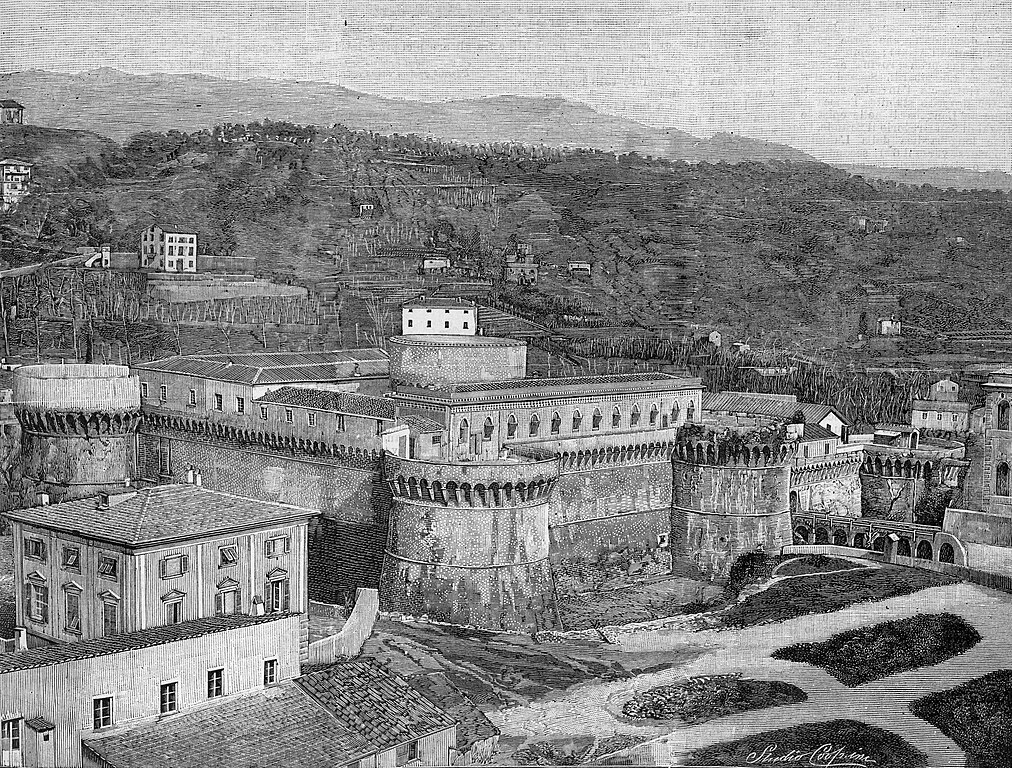
This was the case in the time of our fathers with the Florentine Cecca, into whose hands there came many highly honorable works in his day; and in these he acquitted himself so well, toiling in the service of his country with economy and with great satisfaction to his fellow-citizens, that his ingenious and industrious labors have made him famous and illustrious among the number of distinguished and renowned craftsmen. It is said that in his youth Cecca was a very good carpenter, and that he had concentrated all his powers on seeking to solve the difficulties connected with engines, and how to make machines for assaulting walls in war,scaling-ladders for climbing into cities, battering-rams for breaching fortifications, defenses for protecting soldiers in the attack, and everything that could injure his enemies and assist his friends–wherefore, being a person of the greatest utility to his country, he well deserved the permanent provision that the Signoria of Florence gave him. For this reason, when there was no war going on, he would go through the whole territory inspecting the fortresses and the walls of cities and townships, and, if any were weak, he would provide them with designs for ramparts and everything else that was wanting. It is said that the Clouds which were borne in procession throughout Florence on the festival of St. John,things truly most ingenious and beautiful, were invented by Cecca, who was much employed in such matters at that time, when the city was greatly given to holding festivals. In truth, although such festivals and representations have now fallen almost entirely out of use, they were very beautiful spectacles, and they were celebrated not only by the Companies, or rather, Confraternities, but also in the private houses of gentlemen, who were wont to form certain associations and societies, and to meet together at certain times to make merry; and among them there were ever many courtly craftsmen, who, besides being fanciful and amusing, served to make the preparations for such festivals. Among others, four most solemn public spectacles took place almost every year, one for each quarter of the city, with the exception of that of San Giovanni, for the festival of which a most solemn procession was held, as will be told. The quarter of Santa Maria Novella kept the feast of Sant’Ignazio; Santa Croce, that of St. Bartholomew, called San Baccio; Santo Spirito, that of the Holy Spirit; and the Carmine, those of the Ascension of Our Lord and of the Assumption of Our Lady. This festival of the Ascension, for of the others of importance an account has been or will be given, was very beautiful, seeing that Christ was uplifted on a cloud covered with angels from a Mount very well made of wood, and was borne upwards to a Heaven, leaving the Apostles on the Mount; and the whole was so well contrived that it was a marvel, above all because the said Heaven was somewhat larger than that of Santa Felice in Piazza, although the machinery was almost the same. And since the said Church of the Carmine, where this representation used to take place, is no little broader and higher than that of Santa Felice, in addition to the part that supported Christ another Heaven was sometimes erected, according as it was thought advisable, over the chief tribune, wherein were certain great wheels made in the shape of reels, which, from the centers to the edges, moved in most beautiful order ten circles standing for the ten Heavens, which were all full of little lights representing the stars, contained in little copper lamps hanging on pivots, so that when the wheels revolved they remained upright, in the manner of certain lanterns that are now universally used by all. From this Heaven, which was truly a very beautiful thing, there issued two stout ropes fastened to the staging or tramezzo which is in the said church, and over which the representation took place. To these ropes were attached by each end of a so-called brace-fastening, two little bronze pulleys which supported an iron upright fixed into a level platform, on which stood two angels fastened by their girdles. These angels were kept upright by a counterpoise of lead which they had under their feet, and by another that was under the platform on which they stood; and this also served to make them balanced one with another. The whole was covered with a quantity of cotton-wool, very well arranged in the form of a cloud, which was full of cherubim and seraphim, and similar kinds of angels, varied in color and very well contrived. These angels, when a little rope was unwound from the Heaven above, came down the two larger ropes on to the said tramezzo, where the representation took place, and announced to Christ that He was to ascend into Heaven, and performed their other functions. And since the iron to which they were bound by the girdle was fixed to the platform on which they stood, in such a way that they could turn round and round, they could make obeisance and turn about both when they had come forth and when they were returning according as was necessary; wherefore in reascending they turned towards the Heaven, and were then drawn up again as they had come down. These machines and inventions are said to have been Cecca’s, for, although Filippo Brunelleschi had made similar things long before, many additions were made to them with great judgment by Cecca; and it was from these that the thought came to the same man to make those Clouds which were borne in procession through the city every year on St. John’s Eve, and the other beautiful things that were made. And this was his charge, because, as it has been said, he was a servant of the public.
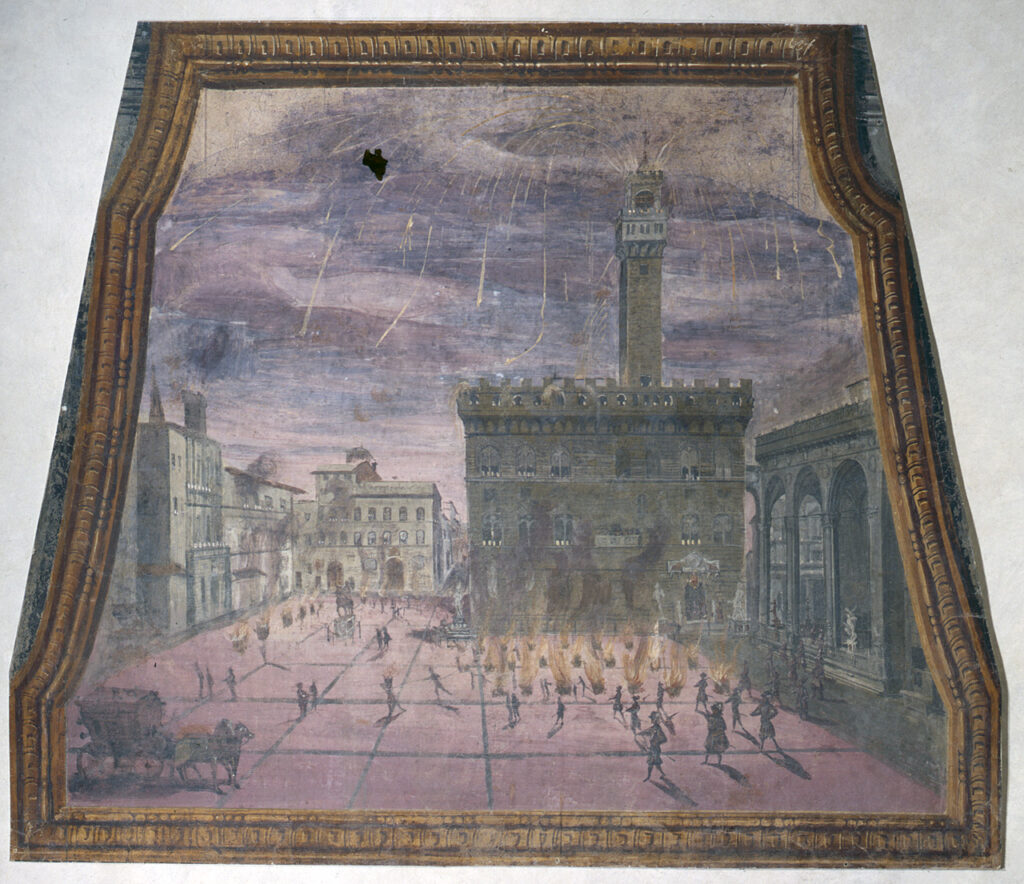
Now with this occasion it will not be out of place to describe some of the features of the said festival and procession, to the end that some memory of them may descend to posterity, seeing that they have now for the most part fallen into disuse. First, then, the Piazza di San Giovanni was all covered over with blue cloth, on which were sewn many large lilies of yellow cloth; and in the middle on certain circles also of cloth, and ten braccia in diameter, were the arms of the People and Commune of Florence, with those of the Captain of the Guelph party and others; and all around, from the borders of the said canopy, which covered the whole piazza, vast as it is, there hung great banners also of cloth, painted with various devices, with the arms of magisterial bodies and guilds, and with many lions, which form one of the emblems of the city. This canopy, or rather , awning, made thus, was about twenty braccia off the ground, and was supported by very strong ropes fastened to a number of irons, which are still to be seen round the Church of San Giovanni, on the facade of Santa Maria del Fiore and on the houses that surround the said piazza on every side. Between one rope and another ran cords that likewise supported the awning, which was so well strengthened throughout, par particularly at the edges, with ropes, cords, linings, double widths of cloth, and hems of sacking, that it is impossible to imagine anything better. What is more, everything was arranged so well and with such great diligence, that although the awning was often swelled out and shaken by the wind, which is always very powerful in that place, as everyone knows, yet it was never disturbed or damaged in any way whatever. This awning was made of five pieces, to the end that it might be easier to handle, but, when set into place, they were all joined and fastened and sewn together in such a manner that it appeared like one whole. Three pieces covered the piazza and the space that is between San Giovanni and Santa Maria del Fiore; and in the middle piece, in a straight line between the principal doors, were the aforesaid circles containing the arms of the Commune. And the remaining two pieces covered the sides,one towards the Misericordia, and the other towards the Canon’s house and the Office of Works of San Giovanni. The Clouds, which were made of various kinds and with diverse inventions by the Companies, were generally fashioned in the following manner. A square framework was made of planks, about two braccia in height, with four stout legs at the corners, contrived after the manner of the trestles of a table, and fastened together with crosspieces. On this framework two panels were laid crosswise, each one braccio wide, with a hole in the middle half a braccio in diameter, in which was fixed a high pole, whereon there was placed a mandorla all covered with cotton-wool, cherubim, lights, and other ornaments, and within this, on a horizontal bar of iron, there sat or stood, according as might be desired, a person representing that Saint whom the particular Company principally honored as their peculiar patron and protector,to be exact, a Christ, or a Madonna , or a St. John, or some other,and the draperies of this figure covered the iron bar in such a manner that it could not be seen. Round the same pole, lower down, below the mandorla, there radiated four or five iron bars in the manner of the branches of a tree, and at the end of each, attached likewise with irons, stood a little boy dressed like an angel. These boys could move round and round at pleasure on the iron brackets on which their feet rested, for the brackets hung on hinges. And with similar branches there were sometimes made two or three tiers of angels or of saints, according to the nature of the subjects to be represented. The whole of this structure, with the pole and the iron bars (which some times represented a lily, sometimes a tree, and often a cloud or some other similar thing), was covered with cotton-wool, and, as has been said, with cherubim seraphim, golden stars, and other suchlike ornaments. Within were porters or peasants, who carried it on their shoulders, placing them selves round the wooden base that we have called the framework, in which, below the places where the weight rested on their shoulders, were fixed cushions of leather stuffed with down, or cotton-wool, or some other soft and yielding material. All the machinery, steps, and other things were covered, as has been said above, with cotton-wool, which made a beautiful effect; and all these contrivances were called Clouds. Behind them came troops of men on horseback and foot-soldiers of various sorts, according to the nature of the story to be represented, even as in our own day they go behind the cars or other things that are used in place of the said Clouds. Of the form of the latter I have some designs in my book of drawings, very well done by the hand of Cecca , which are truly ingenious and full of beautiful conceptions. It was from the plans of the same man that those saints were made that went or were carried in processions, either dead or tortured in various ways, for some appeared to be transfixed by a lance or a sword, others had a dagger in the throat, and others had other suchlike weapons in their bodies. With regard to this, it is very well known today that it is done with a sword, lance, or dagger broken in half, the pieces of which are held firmly opposite to one another on either side by iron rings, after taking away the proportionate amount that has to appear to be fixed in the person of the sufferer; wherefore I will say no more about them , save that they seem for the most part to have been invented by Cecca.
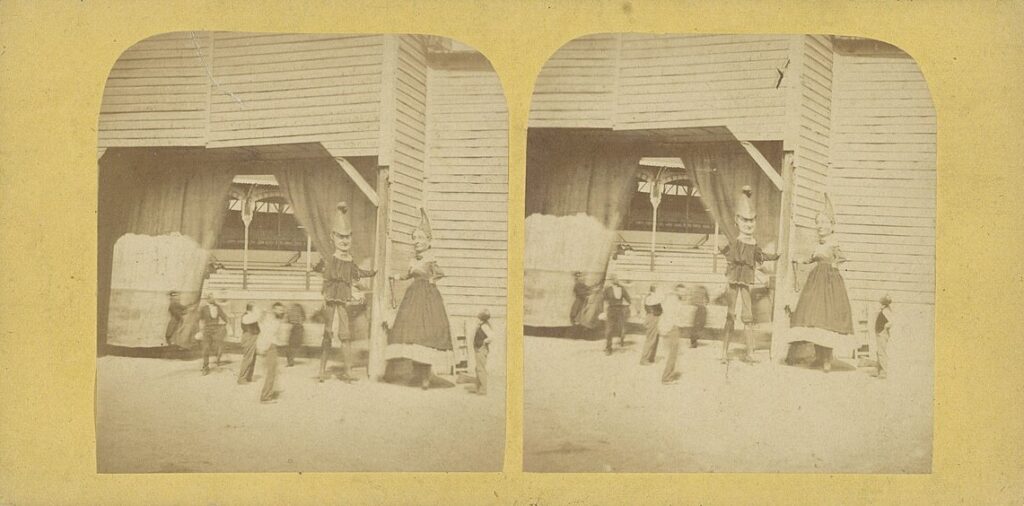
The giants, likewise, that went about in the said festival, were made in the following manner. Certain men who were very skillful at walking on stilts, or, as they are called in other parts, on wooden legs, had some made five or six braccia high, and, having dressed and decked them with great masks and other ornaments in the way of draperies, and imitations of armor, so that they seemed to have the members and heads of giants, they mounted them and walked dexterously along, appearing truly to be giants. In front of them, however, they had a man who carried a pike, on which the giant leant with one hand, but in such a fashion that the pike appeared to be his own weapon, whether mace, lance, or a great bell-clapper, such as Morgante is said by the poets of romance to have been wont to carry. And even as there were giants, so there were also giantesses, which produced a truly beautiful and marvelous effect. Different from these, again, were the little phantoms, for these walked on similar stilts five or six braccia high, without anything save their own proper form, in such a manner that they appeared to be true spirits. They likewise had a man in front of them with a pike to assist them; but it is stated that some actually walked very well at so great a height without leaning on anything whatsoever, and I am sure that he who knows what Florentine brains are will in no way marvel at this. For, not to mention that native of Montughi (near Florence) who has surpassed all the masters that ever lived at climbing and dancing on the rope, whoever knew a man called Ruvidino, who died less than ten years ago, remembers that climbing to any height on a rope or cord, leaping from the walls of Florence to the earth, and walking on stilts much higher than those described above, were as easy to him as it is for an ordinary man to walk on level. Wherefore it is no marvel if the men of those times, who practiced suchlike exercises for money or for other reasons, did what has been related above, and even greater things.
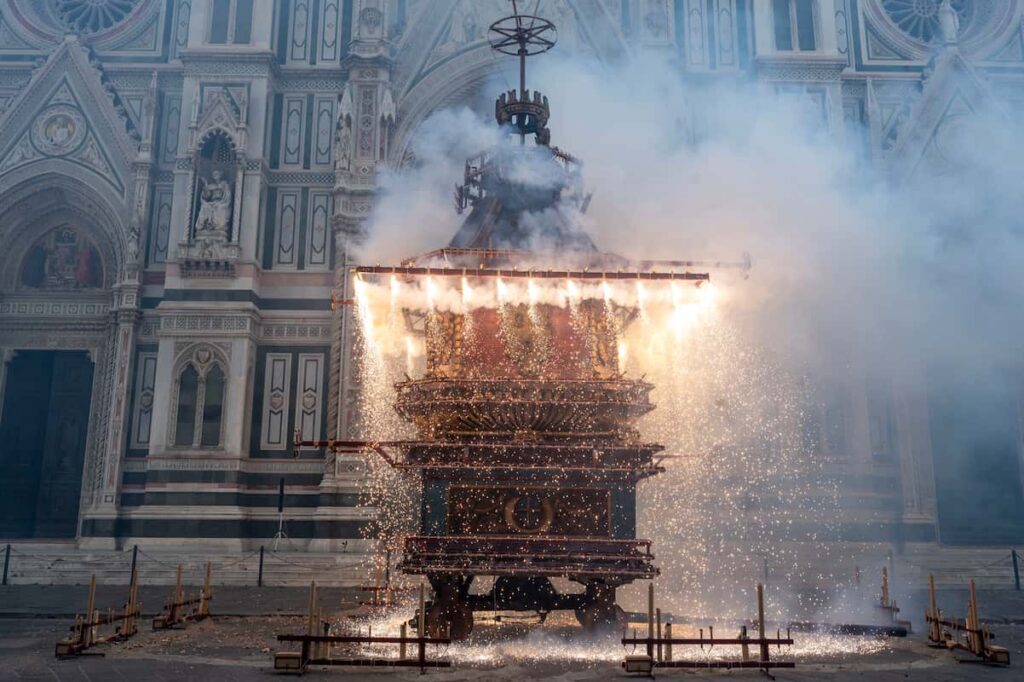
I will not speak of certain waxen candles which used to be painted with various fanciful devices, but so rudely that they have given their name to vulgar painters, insomuch that bad pictures are called “candle puppets “; for it is not worth the trouble. I will only say that at the time of Cecca they fell for the most part into disuse, and that in their place were made the cars that are still used today, in the form of triumphal chariots. The first of these was the car of the Mint, which was brought to that perfection which is still seen every year when it is sent out for the said festival by the Masters and Lords of the Mint, with a S. John on the highest part and with many other angels and saints around and below him, all represented by living persons. Not long ago it was determined that one should be made for every borough that gave an offering of wax, and ten were made, in order to do magnificent honor to that festival; but the plan was carried no further, by reason of events that supervened no long time after. That first car of the Mint, then, was made under the direction of Cecca by Domenico, Marco, and Giuliano del Tasso, who were among the best master-carpenters, both in squared-work and in carving, who were then working in Florence; and in this car, among other things, no small praise is due to the wheels below it, which are pivoted, in order that the structure may be able to turn sharp corners, and may be managed in such a manner as to shake it as little as possible, particularly for the sake of those who stand fastened upon it. The same man made a structure for the cleaning and restoration of the mosaics in the tribune of San Giovanni which could be turned, raised, lowered, and advanced at pleasure, and that with such ease that two men could handle it; which invention gave Cecca very great repute.
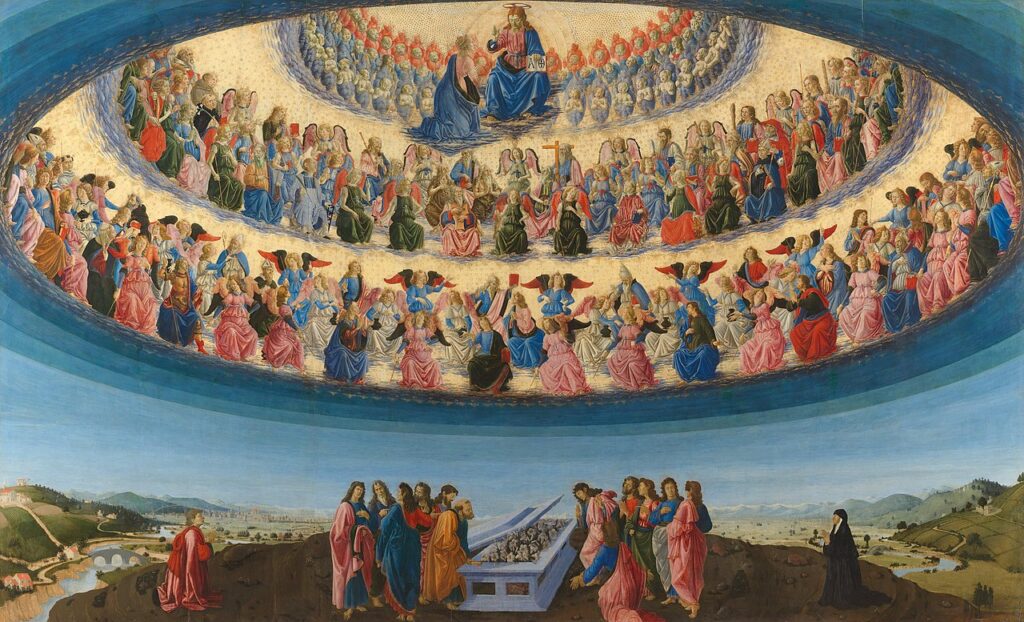
When the Florentine army was besieging Piancaldoli, Cecca ingeniously contrived to enable the soldiers to enter it by means of mines, without striking a blow. Afterwards, continuing to follow the same army to certain other strongholds, his evil fortune would have it that he should be killed while attempting to measure certain heights at a difficult point; for when he had put his head out beyond the wall in order to let a plumb-line down, a priest who was with the enemy (who feared the genius of Cecca more than the might of the whole camp) discharged a catapult at him and fixed a great dart in his head, inso much that the poor fellow died on the spot. The fate and the loss of Cecca caused great grief to the whole army and to his fellow-citizens; but since there was no remedy, they sent him back in a coffin to Florence, where his sisters gave him honorable burial in San Piero Scheraggio; and below his portrait in marble there was placed the following epitaph:
Fabrum magister Cicca, natus oppidis vel obsidendis, vel tuendis hic iacet.
Vixit annos XXXXI menses VI dies XIIII.
Obiit pro patria telo ictus.
Piae sorores monumentum fecerunt MCCCCLXXXXVIIII.
Homepage: Reconstruction of a florentine ephemeral apparatus of the Medici era depicting an angelic choir (detail of the wooden model made in 1975 by Ludovico Zorzi and Cesare Lisi), Pratolino, Villa Demidoff (www.cittametropolitana.fi.it).
Below: Reproduction of pages 440-447 of Giorgio Vasari's "Le vite de' più eccellenti pittori, scultori e architetti", Giunti, Florence 1568, Part II (www.archive.org).








